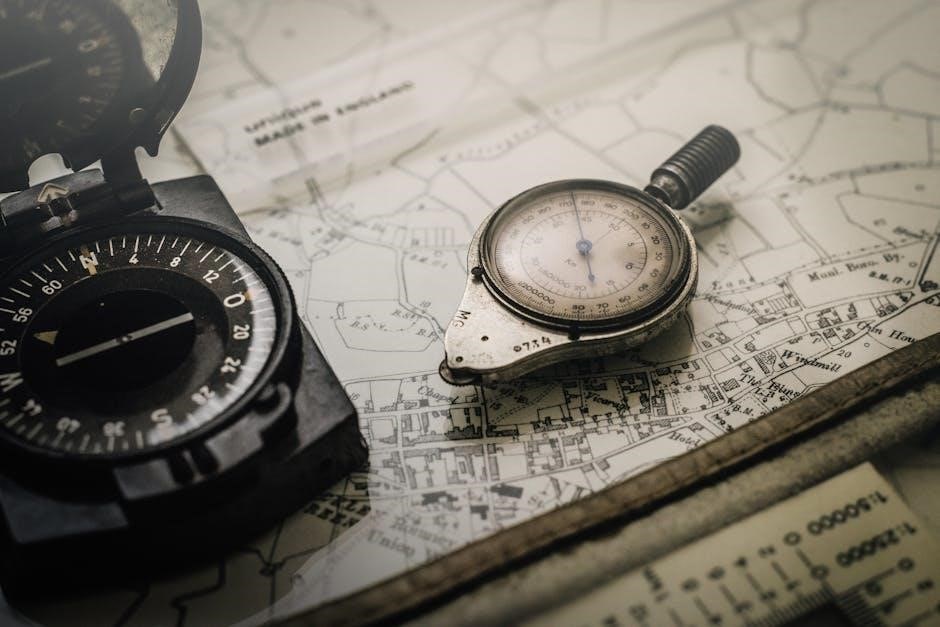Kilometers to Miles Conversion Chart PDF: A Comprehensive Guide
This guide provides a comprehensive overview of kilometers to miles conversion, offering practical methods and resources. It includes conversion factors, estimation techniques, and printable charts. Discover the applications of this conversion in various contexts and explore helpful online tools. Access free printable charts for quick reference and convenient use.
Kilometers (km) and miles (mi) are units of length used in different measurement systems worldwide. The kilometer, a metric unit, is commonly used in most countries for measuring distances, while the mile, an imperial unit, is primarily used in the United States and the United Kingdom. Understanding the relationship between these units is essential for various applications, including travel, sports, and scientific research.
The kilometer is defined as one thousand meters, where a meter is the base unit of length in the metric system. Conversely, a mile is defined as 5,280 feet or 1,760 yards. The need for converting between kilometers and miles arises frequently due to the prevalence of both systems across different regions.
This conversion is not only useful for practical purposes but also for interpreting data presented in different units. Whether you’re planning a road trip, analyzing athletic performance, or simply trying to understand a geographical distance, knowing how to convert between kilometers and miles is a valuable skill. This comprehensive guide will provide you with the tools and knowledge necessary to perform these conversions accurately and efficiently.
Understanding the Conversion Factor
The cornerstone of converting kilometers to miles lies in understanding the conversion factor. This factor acts as the bridge between the two units, allowing for accurate and reliable conversions. The precise conversion factor is that 1 kilometer is approximately equal to 0.621371 miles. Conversely, 1 mile is approximately equal to 1.609344 kilometers.
This means that to convert kilometers to miles, you multiply the number of kilometers by 0.621371. For example, to convert 10 kilometers to miles, you would multiply 10 by 0.621371, resulting in approximately 6.21 miles. Similarly, to convert miles to kilometers, you multiply the number of miles by 1.609344.
While the exact conversion factor provides the most accurate results, it’s also important to be aware of simplified approximations for quick mental calculations. Understanding the conversion factor not only allows you to perform accurate conversions but also provides a deeper understanding of the relationship between the metric and imperial systems. This knowledge is invaluable in various fields and everyday situations, making the conversion process more intuitive and efficient.
Quick Estimation Methods for Mental Conversion
When a calculator isn’t available, quick estimation methods become invaluable for converting kilometers to miles mentally. One simple approach involves multiplying the kilometer value by 0.6. While not perfectly accurate, this method provides a reasonable approximation for many everyday situations. For example, estimating 5 kilometers, multiplying by 0.6 gives you 3 miles.
A slightly more accurate method involves multiplying the kilometer value by 2 and then dividing the result by 3. This approach leverages the relationship that 3 miles is roughly equivalent to 5 kilometers. Applying this to 10 kilometers, multiplying by 2 yields 20, and dividing by 3 gives approximately 6.67 miles.
Another technique uses the Fibonacci sequence. Since the ratio between consecutive Fibonacci numbers approximates the kilometers-to-miles conversion factor. To estimate, choose a number in the sequence for kilometers; the preceding number approximates the miles. For example, 21 kilometers is about 13 miles. These mental conversion methods allow for quick estimations. Choosing the right method depends on the desired accuracy and the ease of calculation.

Using Online Kilometers to Miles Calculators
Online kilometers to miles calculators offer a quick and accurate way to convert distances. These tools eliminate manual calculations, providing instant results with a few clicks. Simply enter the distance in kilometers, and the calculator will display the equivalent distance in miles. This method is particularly useful when precise conversions are needed, or for complex numbers.
Many websites provide free and user-friendly kilometers to miles calculators. These calculators often include additional features, such as the ability to convert in both directions (kilometers to miles and miles to kilometers). Some also offer historical conversion rates.
Using an online calculator is straightforward. Visit a reputable conversion website, locate the kilometers to miles calculator, enter the kilometer value, and view the converted miles value. These calculators are accessible on various devices, including computers, tablets, and smartphones, ensuring convenience wherever you are. Online calculators provide a reliable solution for accurate and fast distance conversions, making them an essential tool for various applications.
Creating a Printable Kilometers to Miles Conversion Chart
Creating a printable kilometers to miles conversion chart offers a convenient reference for quick distance conversions. These charts are particularly useful when you need to convert distances without relying on online tools or calculators. To create your own chart, start by listing kilometers in one column and calculate the corresponding miles for each value.
You can use a spreadsheet program like Microsoft Excel or Google Sheets to easily generate the chart. Enter kilometers in increments (e.g., 1 km, 2 km, 3 km) and use the formula to convert each value to miles. Ensure the chart is clear and easy to read by using appropriate formatting.
Once the chart is complete, save it as a PDF file to maintain its formatting when printing. Printable charts can be customized to include specific kilometer ranges or increments that suit your needs. Keep a printed chart in your car, office, or home for quick and easy distance conversions. A well-designed conversion chart is an invaluable tool for everyday use.

Applications of Kilometers to Miles Conversion
The conversion between kilometers and miles has numerous practical applications across various fields. In transportation, it’s essential for understanding distances on road signs and maps, particularly when traveling between countries using different measurement systems. Athletes and fitness enthusiasts use this conversion to track their performance, whether running, cycling, or swimming, and to compare distances in different units.
In education, it helps students learn about different units of measurement and their relationships. Geography and science lessons often involve converting distances to better understand spatial relationships. Real estate professionals use kilometers to miles conversion when dealing with international clients or properties measured using the metric system.
Moreover, many online tools and calculators rely on this conversion to provide accurate results. Weather reports, scientific research, and engineering projects also require the ability to switch between these units. Understanding these applications is crucial for anyone working or studying in these fields, making the conversion skill highly valuable.
Kilometers to Miles Conversion Table (Example)
A kilometers to miles conversion table provides a quick reference for converting distances between the two units. For instance, 1 kilometer is approximately equal to 0.621371 miles. Therefore, a table would list kilometers in one column and their corresponding mile equivalents in another. This table can start with 1 km = 0.621371 mi and increment by one kilometer for each subsequent row.
For example, 2 km equals 1.242742 miles, 3 km equals 1.864113 miles, and so on. The table can extend to cover a range of commonly used distances, such as up to 10 km, 20 km, or even 100 km, depending on the intended use.
Such a table is useful for quickly looking up values without performing calculations. It is beneficial for runners, cyclists, and travelers who frequently need to convert distances. It is particularly helpful for those who prefer a visual reference rather than using a calculator. Conversion tables are often included in printable charts and online resources for easy access and convenience.
Free Printable Kilometers to Miles Charts
Free printable kilometers to miles charts offer a convenient and accessible resource for quick distance conversions. These charts typically present a table format, listing kilometer values alongside their corresponding mile equivalents. The availability of these charts in PDF format ensures easy downloading and printing, making them readily usable in various settings.
These charts cater to individuals who prefer a tangible reference tool over digital calculators. Whether for educational purposes, travel planning, or fitness tracking, a printed conversion chart can be invaluable. Many websites and online conversion tools offer these charts for free, often customizable to specific needs.
Users can find charts that cover different ranges of distances, from small increments to larger values, ensuring suitability for diverse applications. Some charts may also include additional information, such as conversion formulas or quick estimation methods. Having a printable kilometers to miles chart on hand simplifies the process of converting distances, eliminating the need for constant online access or manual calculations.
Common Distances in Kilometers and Miles

Understanding common distances in both kilometers and miles provides a practical perspective on measurement conversions. For instance, a 5K race, popular in many running communities, is approximately 3.1 miles. A 10K race translates to about 6.2 miles, offering a familiar context for runners accustomed to either metric or imperial units.
Half marathons, spanning 21.1 kilometers, equate to roughly 13.1 miles. Full marathons cover 42.2 kilometers, which is approximately 26.2 miles. These benchmark distances are widely recognized and frequently used in fitness tracking and competitive events.
In everyday contexts, knowing these conversions can be useful. For example, a short drive of 10 kilometers is about 6.2 miles, while a longer trip of 100 kilometers is roughly 62.1 miles. These conversions are essential for international travel, allowing individuals to easily interpret distances displayed in different units. Familiarity with these common distances enhances comprehension and facilitates smoother navigation across various scenarios.
Converting Miles to Kilometers
Converting miles to kilometers is a straightforward process with several handy methods. The primary conversion factor is that 1 mile equals approximately 1.60934 kilometers. Therefore, to convert miles to kilometers, you simply multiply the number of miles by this factor. For instance, if you want to convert 5 miles to kilometers, you would multiply 5 by 1.60934, resulting in approximately 8.0467 kilometers.
For a quick mental estimation, you can use the approximation that 1 mile is roughly 1.6 kilometers. This simplifies the calculation, making it easier to estimate distances on the go. For example, to convert 10 miles, multiplying by 1.6 gives you 16 kilometers.
Another method involves dividing the number of miles by 5 and then multiplying by 8. This technique offers a close estimate and can be useful when a calculator isn’t available. These methods are helpful for travel, sports, and everyday situations where quick conversions are needed.

Resources for Kilometers to Miles Conversion
Numerous resources are available to facilitate kilometers to miles conversions. Online conversion calculators provide instant and accurate results, eliminating manual calculations. These calculators often include additional features, such as conversion history and the ability to convert other units of measurement. Websites dedicated to unit conversions offer comprehensive tools and information, including conversion formulas and tables.
Printable conversion charts are valuable for quick reference, especially when internet access is limited. These charts typically list common kilometer values and their corresponding mile equivalents, making it easy to find the conversion you need. Many websites offer free, downloadable conversion charts in PDF format.
Mobile apps designed for unit conversions are also readily available. These apps offer on-the-go conversion capabilities and often include features like offline access and customizable settings. Educational websites and tutorials provide step-by-step instructions and explanations of the conversion process, helping users understand the underlying principles.

